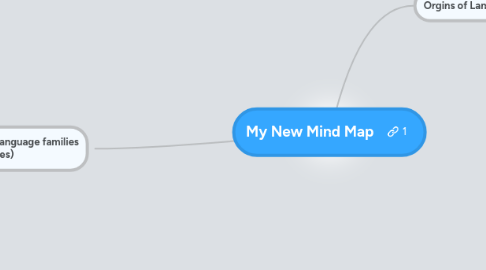
1. Orgins of Language
1.1. Kurgan origin
1.1.1. These people lived in steppe areas near Kazakhstan and Russia
1.1.2. Earliest evidence dates back to 4300 BC
1.1.3. Nomadic herders and among first to domesticate horses and cattle – took language with them as migrated in search of grass for animals
1.1.4. Used horses to conquer much of Europe and S. Asia
1.2. Anatolia Origin:
1.2.1. These people lived in Anatolia (part of Turkey)
1.2.2. Earliest evidence dates back to 6300 BC
1.2.3. Mostly farmers and took agricultural practices with them as migrated through parts of Europe and Asia
2. prehistoric language families (superfamilies)
2.1. austric
2.1.1. come the Austronesian language family spoken today on many islands in the south pacific. Also the austro asiatic languages of which the largest is Vietnamese, descended from the austric super family.
2.2. nostratic
2.2.1. come today's dravidian, Altaic, uralic afro-asiatic, and indo european familes
2.3. sino-caucasian
2.3.1. for runner to today's sino-tibetan language family
2.4. language families
2.4.1. Indo-European (nostratic)
2.4.1.1. More than 3 billion people speak languages of the Indo-European Family
2.4.1.2. language branches
2.4.1.2.1. Germanic
2.4.2. sino-tibetan (sino-cauasian)
2.4.2.1. Second largest language family spoken by 1/4th of the world
2.4.2.2. Sinitic branch
2.4.2.2.1. Mandarin is spoken by 3/4th of Chinese Mandarin is most used language in world. Official language of People’s Republic of China and Taiwan
2.4.2.3. Two smaller branches, Austro-Thai and Tibeto-Burman spoken in Laos, Thailand and parts of Vietnam and in Myanmar
2.4.3. tai-kadai (sino-caucasian)
2.4.3.1. Once classified as a branch of Sino-Tibetan, the principal languages of this family are spoken in Thailand and neighboring portions of China.
2.4.4. nilo-saharan (sino-caucasian)
2.4.4.1. Languages of this family are spoken by a few million people in north-central Africa, immediately north of the Niger-Congo language region.
2.4.5. hmong (sino-caucasian)
2.4.5.1. hmong language
2.4.6. niger-congo (sino cauasian)
2.4.6.1. More than 95 percent of the people in sub- Saharan Africa speak languages of the Niger-Congo family.
2.4.6.2. benue-congo (language branch)
2.4.6.2.1. igbo comes from the language branch benue-congo, which i chinwuba ezesike and 3 million other africans speak
2.4.7. quechuan (sino cauasian)
2.4.8. guarani (sino cauasian)
2.4.9. altaic (nostratic)
2.4.9.1. Turkish is most popular Altaic language
2.4.9.2. These languages are thought to have originated in the steppes bordering the Qilian Shan and Altai mountains between Tibet and China.
2.4.10. uralic (nostratic)
2.4.10.1. Uralic languages originated in Ural mountains of Russia
2.4.10.2. Finnic is a language branch of the uralic family
2.4.10.2.1. which the language spoken are finnish which are spoken in Estonia, Finland, and Hungary
2.4.11. dravidian (nostratic)
2.4.11.1. A language in the Dravidian family is spoken by 4 percent, mostly in India.
2.4.11.2. tamil is the most spoken lanauage from this family
2.4.12. afro-asiatic (nostratic)
2.4.12.1. The Afro-Asiatic-—once referred to as the Semito-Hamitic—language family includes Arabic and Hebrew, as well as a number of languages spoken primarily in northern Africa and southwestern Asia.
2.4.12.2. semitic (language branch)
2.4.12.2.1. Arabic is the major Afro-Asiatic language and from the semitic language branch, an official language in two dozen countries of North Africa and southwestern Asia, from Morocco to the Arabian Peninsula.
2.4.13. japanese (austric?)
2.4.13.1. japanese language
2.4.14. korean (austric?)
2.4.14.1. Usually classified as a separate language family, Korean may be related to the Altaic languages of Central Asia or to Japanese.
2.4.15. austronesian (austric)
2.4.15.1. Spoken by about 6 percent of the world s people, speakers of Austronesian languages are mostly in Indonesia
2.4.15.2. languages from austronesian is indonesian and flippio
2.4.16. austro-asiatic (austric)
2.4.16.1. Spoken by about 2 percent of the worlds population, Austro-Asiatic is based in Southeast Asia
2.4.16.2. Vietnamese is the most spoken tongue of the Austro-Asiatic language family
